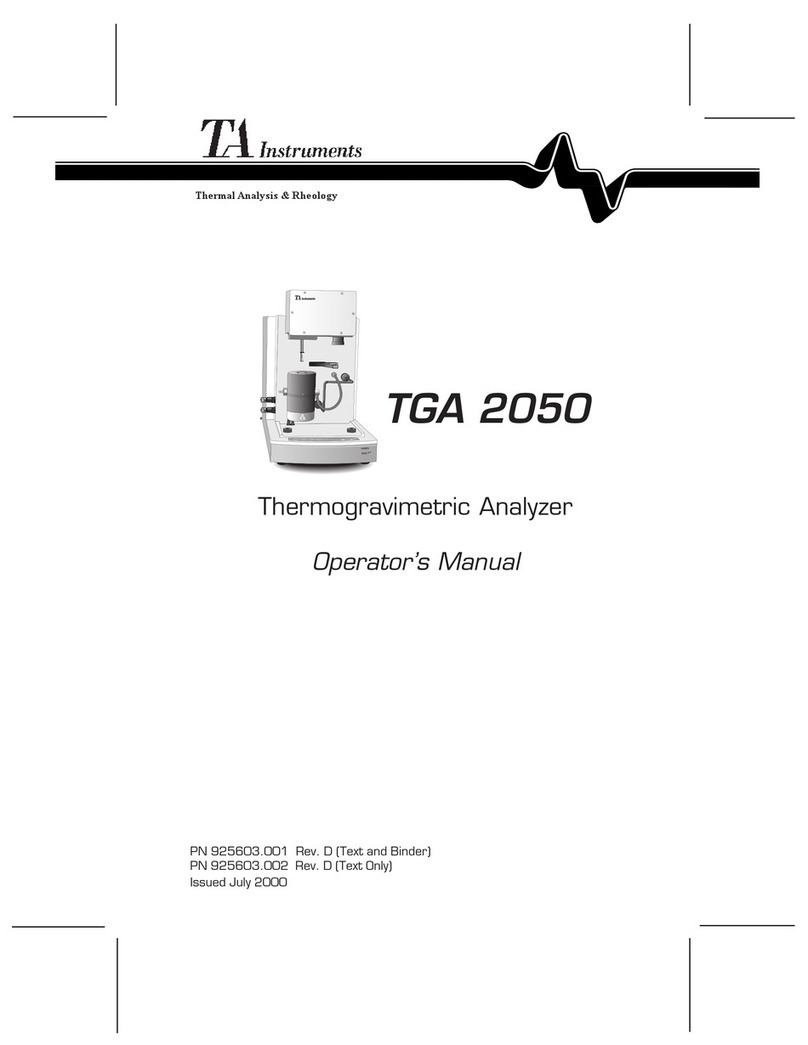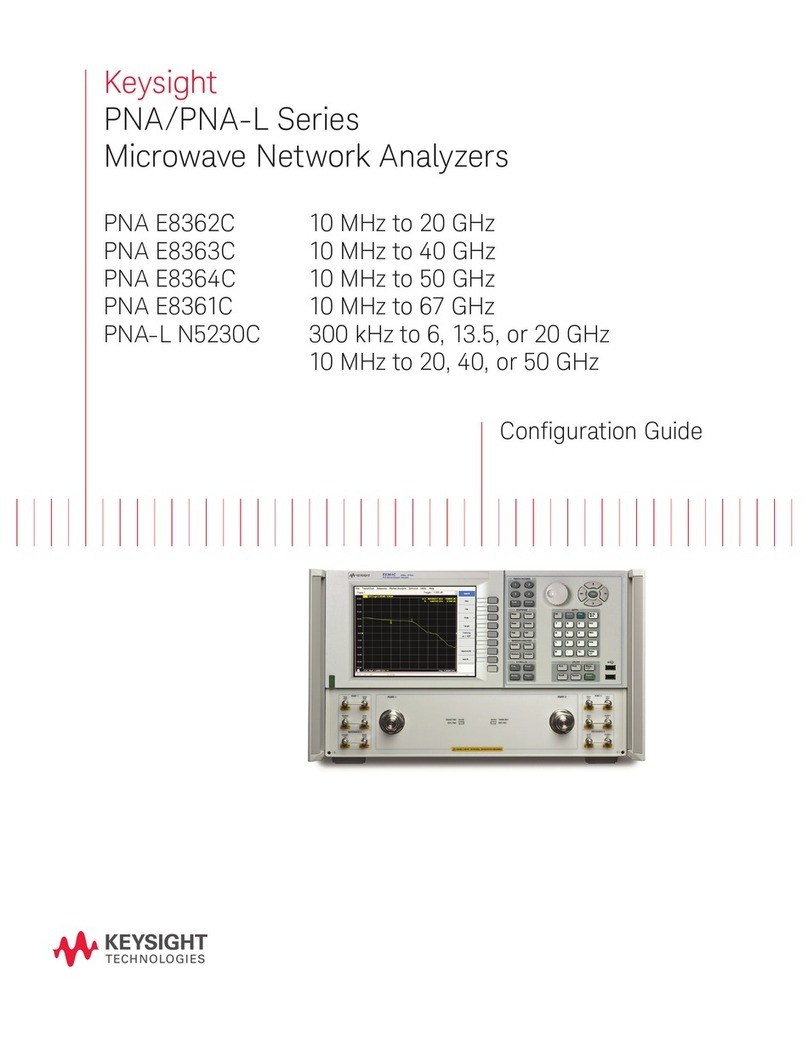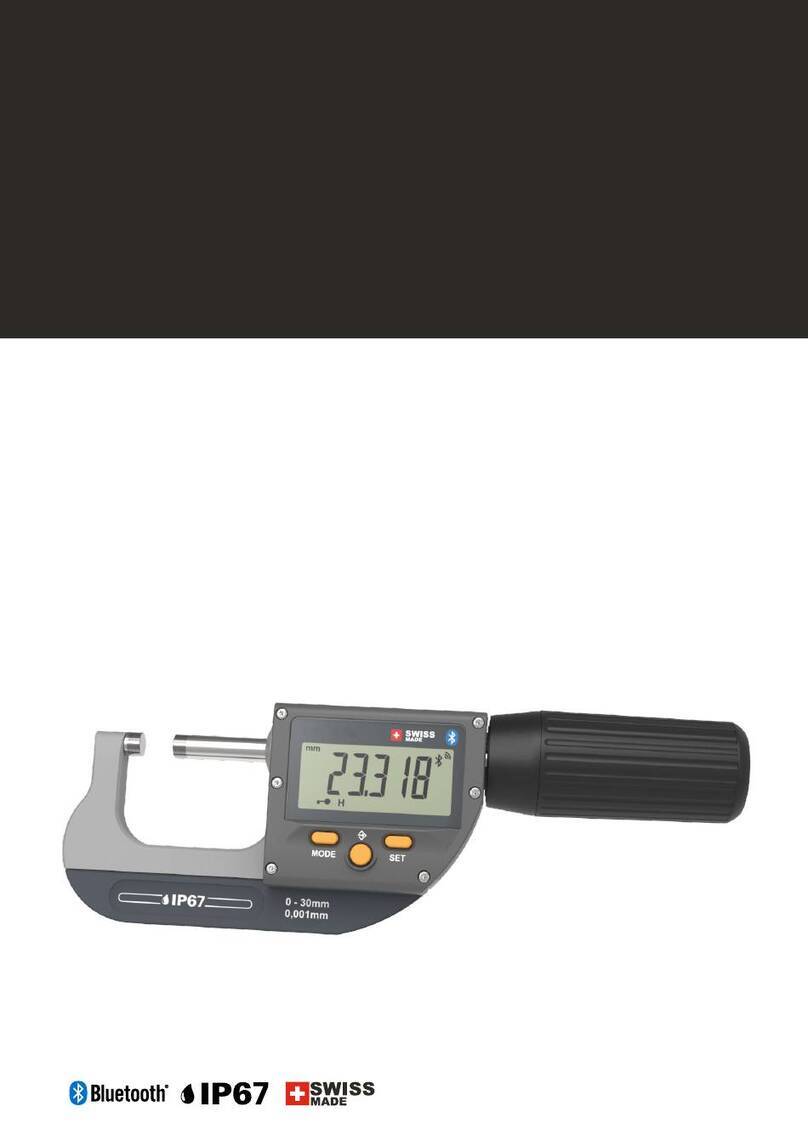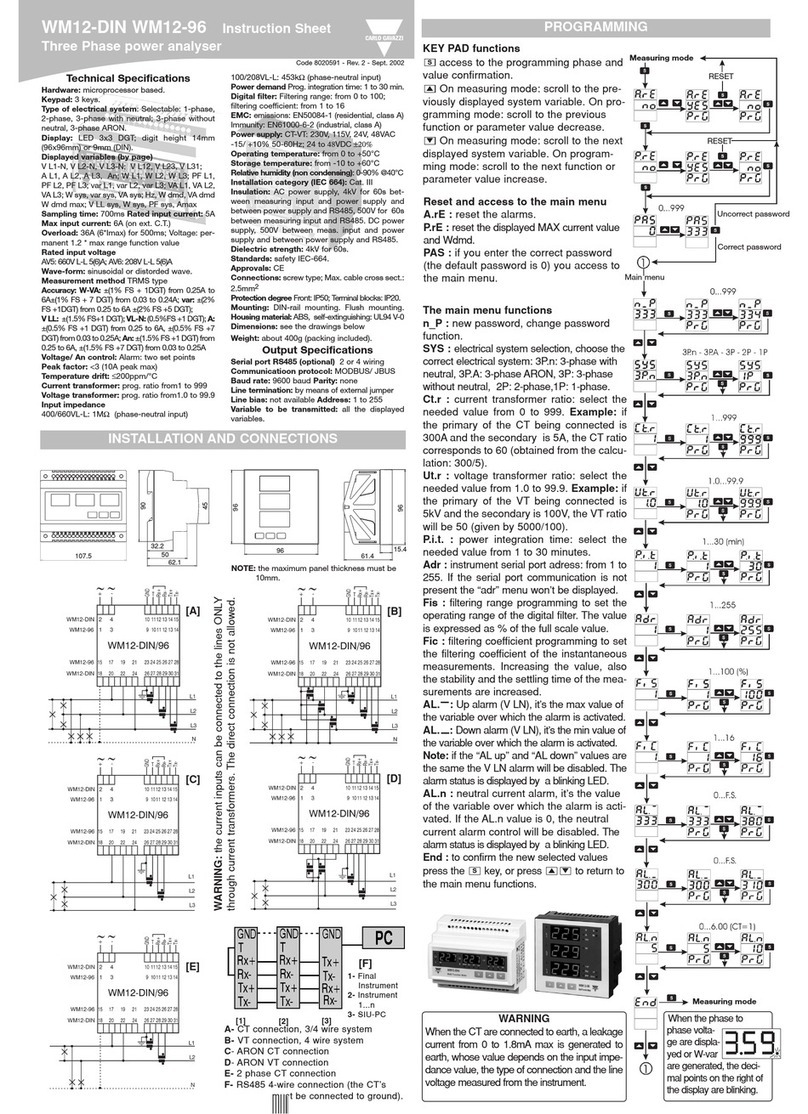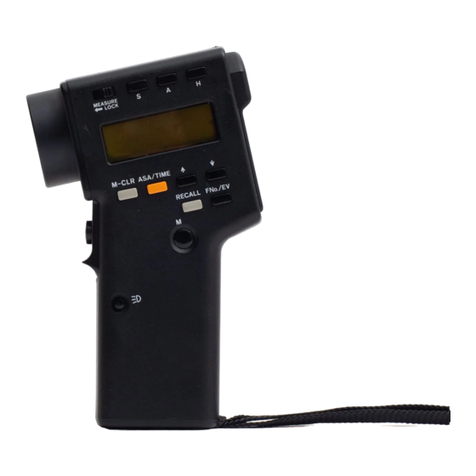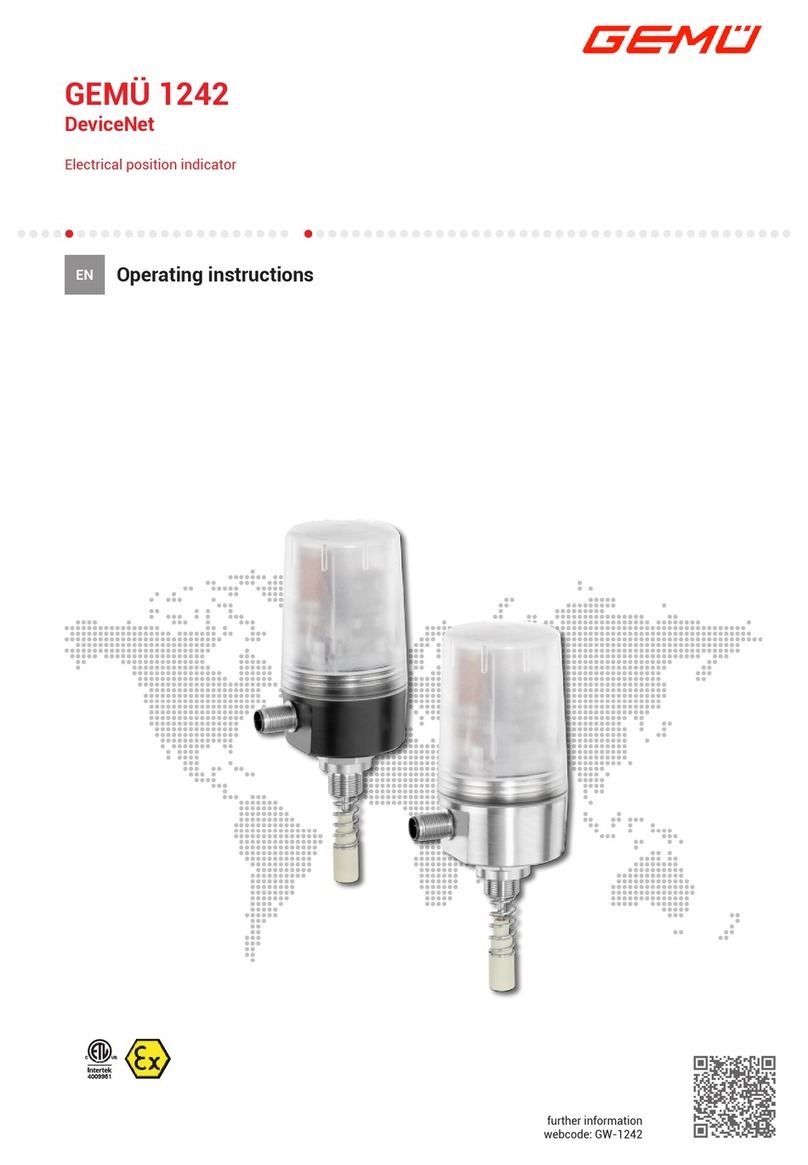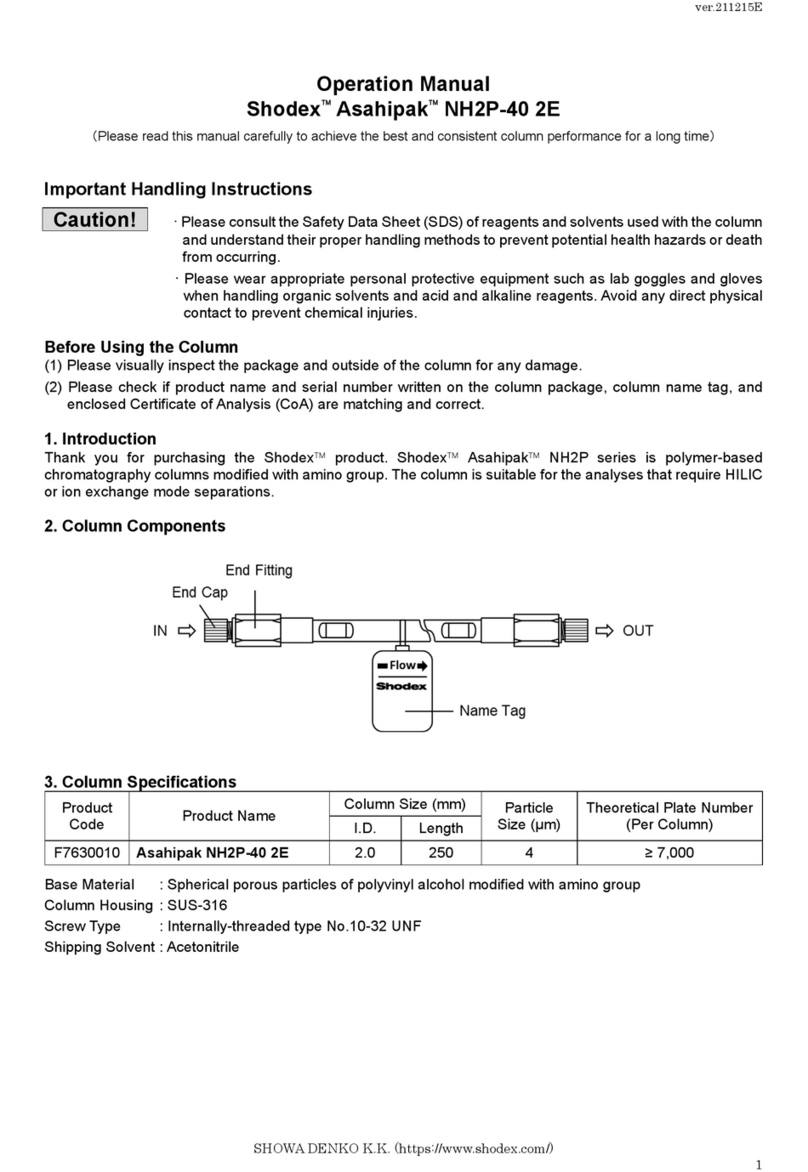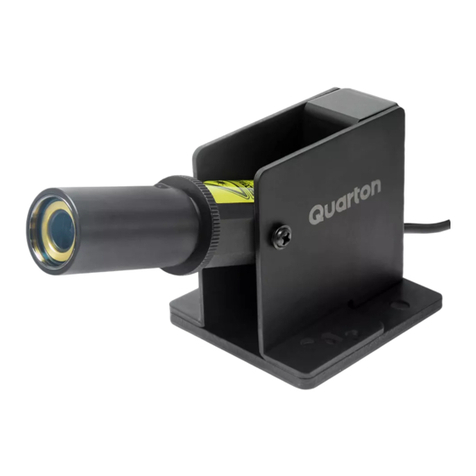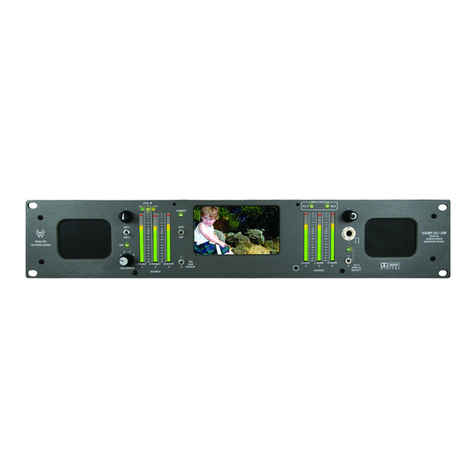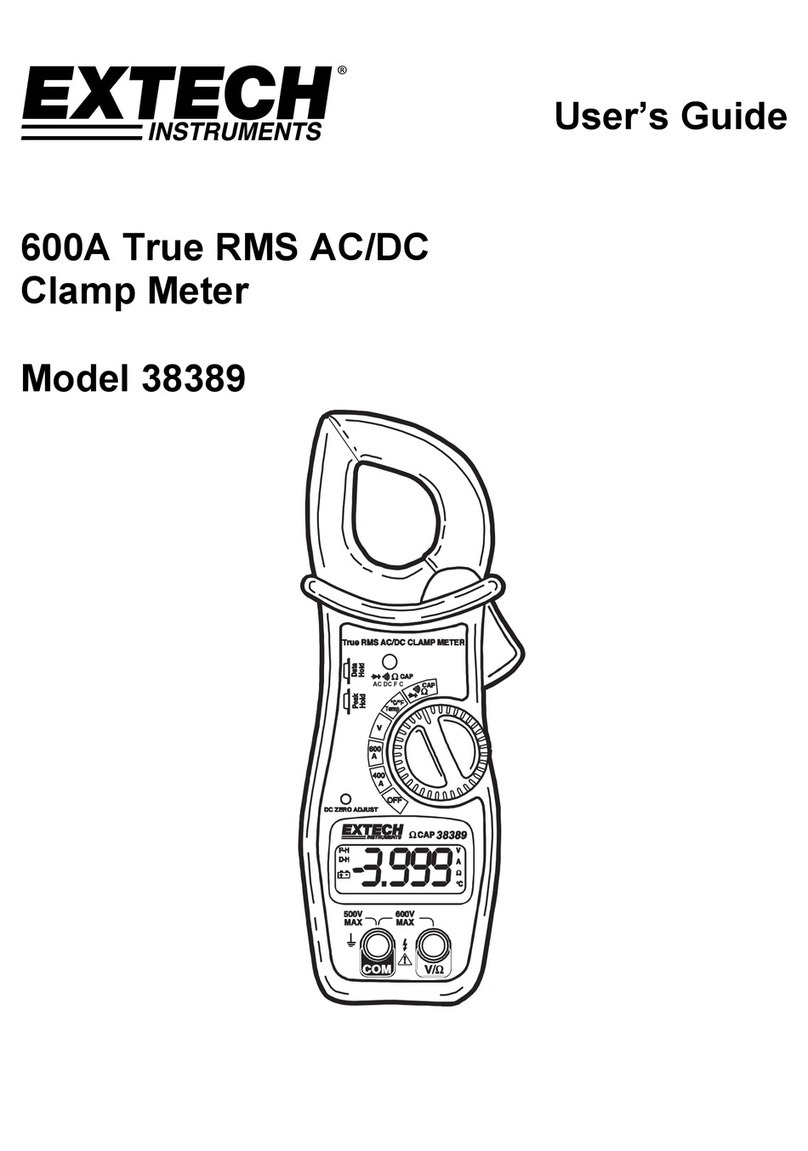BERTHOLD TECHNOLOGIES LB 379 User manual

Measuring Path
LB 379 and LB 3602 / 3603
Operating Manual
40437BA2
Rev. No.: 00, 12/2016

LB 379
2

LB 379
3
Contents
OPERATING MANUAL .....................................................................1
40437BA2......................................................................................1
REV. NO.: 00, 12/2016 ..................................................................1
1OVERVIEW...........................................................................6
1.1 The Principle of Measurement ................................................................ 6
1.2 The Measurement Device........................................................................ 8
1.3 Device Configuration (Operating Modes)................................................ 9
1.3.1Setting the Detector Code..................................................................9
1.3.2Measuring Path Dimension .................................................................9
1.4 Measuring Paths and Sources............................................................... 10
1.4.1Measuring Path LB 379 .................................................................... 10
1.4.2Measuring Paths LB 3602/3603......................................................... 11
1.4.3Radioactive Sources ........................................................................ 12
1.5 Detector................................................................................................ 12
2INSTALLATION...................................................................13
2.1 Installation of the Measuring Path........................................................ 13
2.1.1Safety Instructions.......................................................................... 13
2.1.2Selection of Measuring Site .............................................................. 14
2.1.3Installation Instructions for PTFE lined Measuring Paths (LB 379)........... 16
2.1.4Installation of the Resistance Thermometer Pt 100 .............................. 16
3WATER COOLING IN THE MEASURING PATH LB 379 .........17
3.1 Cooling Water Requirement.................................................................. 17
4ELECTRICAL CONNECTIONS ...............................................18
4.1 Detector................................................................................................ 18
5TECHNICAL DATA...............................................................19
5.1 Measuring Path LB 379......................................................................... 19
5.2 Measuring Path LB 3602/3603:............................................................ 20
5.3 Pressure Equipment Directive 2014/68 / EU........................................ 21
6RADIATION PROTECTION ..................................................22
6.1 Emergency Instructions........................................................................ 25
6.1.1Checking the Crystal-Multiplier Assembly ........................................... 26
7APPENDIX..........................................................................28
7.1 Table 1: Absorption Coefficients ........................................................... 28
7.1.1Temperature Coefficients ................................................................. 29
8DENSITY OF WATER AS A FUNCTION OF THE TEMPERATURE30
9DIMENSIONAL DRAWINGS.................................................31
9.1 Measuring Path LB 379 with DIN Flange............................................... 31
9.2 Measuring Path LB 379 with ASA Flange............................................... 32
9.3 Measuring Path LB 379 with Threaded Connector................................. 33
9.4 Measuring Path LB 3602/03 ................................................................. 34
10 ATEX CERTIFICATE ............................................................35
11 INDEX................................................................................42

LB 379
4

LB 379
5
Safety Summary
Electrical Shock Hazard
Disconnect power to ensure that contact with energized part is avoided during installation and
servicing.
Specific Warnings
Never change the installation or the parameter settings without a full knowledge of the rele-
vant part of this manual, the connected controller and the process, if it is controlled by this
measuring device.
Radiation Protection Instructions
This measuring system uses radioactive sources. The radiation protection information in this
operating manual and the relevant statutory provisions must be strictly observed.
At least one screw on the access openings to the radioactive sources on the measuring path
is sealed. Do not open any sealed screws. A damaged seal must be repaired immediately by
a representative of the manufacturer.
Sources that are not in use must be kept in a secure place and protected against access by
unauthorized persons.

LB 379
6
1Overview
The radiometric density measuring system offers the possibility to measure the density of
liquids, suspensions, slurries and bulk goods. The measurement can be carried out directly
in a product line. The measurement is independent of variations in pressure or viscosity,
and on the flow rate of the product.
1.1The Principle of Measurement
The density measurement utilizes as a measuring effect the attenuation of gamma radia-
tion passing through the product being measured. The residual radiation picked up by the
detector (scintillator) is a measure of the density of the product being measured.
The attenuation of radiation takes place in accordance to the following law:
Figure 1: Principle of measurement
I = radiation picked up by the detector
Io = unattenuated radiation
µ = mass attenuation coefficient (absorption coefficient in cm2/g
= density of absorbing material in g/cm3
d = thickness of absorbing material in cm
The intensity of the radiation arriving at the detector is also dependent on the distance
between source and detector. As in the case of light, the function involved is a square
function, i.e. doubling the distance reduces the radiation intensity to ¼ if all other condi-
tions remain unchanged.
In the measuring paths LB 379 and LB LB3602/3603, source, measurement pipe and de-
tector are combined into one unit. This ensures a fixed geometry and a constant distance.
Under these conditions, the radiation arriving at the detector is only dependent on the
density of the material to be measured.
An activation of the product being measured, or of the pipe used for the measurement by
the gamma radiation is completely excluded.
With the isotopes 241Am and 244Cm the absorption is dependent, in addition to the density,
on the atomic number of the absorber. It increases with increasing atomic number (see
Figure 2), so that with the substances occurring in practice we can almost always assume
that a higher atomic number can also be equated with a higher absorption coefficient. Due
to this relationship, very high measurement accuracies can be achieved for products con-
taining substances with a high atomic number (e.g. hydrochloric acid, milk of lime, sulfuric
acid, etc.), with the measuring paths LB 379 and LB 3602/3603, which are equipped with
one of these isotopes.
d
oeII **
*
d
Io I
Radiation
source Detector

LB 379
7
Figure 2: Absorption coefficients
With 244 cm, the atomic number has a significant influence on the absorption coefficient.
This isotope is incorporated in the measuring paths LB 3602/3603. These measuring paths
are used to measure materials with high atomic number at very low concentrations. These
measuring paths are not type approved.
This dependence of the absorption coefficient on the atomic number has a positive effect
if, for example, in a solution of sodium chloride in water, where the salt content is to be
determined, contaminations by hydrocarbons may occur, for example by sugar or cellulose,
in varying proportions. The lower absorption coefficient of the impurity results in a lower
influence on the measurement result.
An adverse effect is obtained if, for example, the density of a hydrocarbon mixture is to be
determined, which contain impurities by a substance having a high atomic number, such
as chlorine. In this case we get significant changes in the absorption of the radiation even
with low fluctuations in the chlorine content, so that a density change is simulated, which
in reality does not exist.
0,01
0,1
1
10
100
0 5 10 15 20 25 30 35
Absorption coefficient µ
Atomic number Z
Cs - 137 (662 keV)
Am - 241 (60 keV)
Cm 244 (18 keV)
Co -60 (1,3 MeV)

LB 379
8
1.2The Measurement Device
The radiometric density measuring system can be used to measure the density of
liquids
suspensions
solids and
bulk goods
The measurement can be performed directly on a product line and is independent of fluc-
tuations in pressure and viscosity, as well as in the flow velocity.
Specific device configurations and calculations allow you to adapt the density measuring
system to local conditions and the conditions of the product being measured.
The measuring device generally comprises the following components:
a) the measurement path with
- radioactive source
- through pipe for the product to be measured
- detector
b) the evaluation unit
c) the connection cable
d) the resistance thermometer Pt 100 (optional)
The detector's supply voltage and
the measurement signal and im-
portant information (high-voltage
setting, detector temperature,
product temperature with con-
nected Pt 100, etc.) are transmitted
from the detector to the evaluation
unit via the connection cable be-
tween the detector and evaluation
unit.
Figure 3: Measuring arrangement
a) c)
d)
b)
BERTHOLD
LB 444 - 1 V 1.0
Density -Meter etc.
enter
clear run
RADIOACTIVE

LB 379
9
1.3Device Configuration (Operating Modes)
The evaluation unit can be used for different tasks.
Density measurement without temperature compensation (TC)
Density measurement with temperature compensation
via Pt100 or
density measurement with temperature compensation via current input
Suspension measurement with any carrier liquid
solid density and liquid density are known
with or without TC
Suspension measurement with water as the carrier liquid
solid density is known
with water temperature compensation, the density of the water and
the concentration of the solid material are taken into account for temperature
compensation
Mass flow measurement without TC (in connection with a volume flow meter)
Mass flow measurement with TC via Pt 100 (in connection with a volume flow
meter)
Measurement modes
Continuous measurement
Discontinuous measurement
Batch operation via keyboard (press <run> button)
Batch operation via digital input
1.3.1 Setting the Detector Code
Internal device parameters are adjusted to suit the used scintillator size by setting
the detector code. The correct detector code is set at the factory and a change is
not normally required. A table with the detector codes to be used is found below:
Measuring Path Detector Code
LB 379 2
LB 3602/3603 manual
For the measuring path LB 3602/3603 you must set the HV working point to manually
fixed value. If the value is not known you must evaluate the value by a plateau measure-
ment. The plateau measurement is descriped in the manual LB 474 respectively LB 444.
The HV working point must be entered in the evaluation unit at the mid of the plateau
curve.
1.3.2 Measuring Path Dimension
Input of the measuring path dimension in the evaluation unit:
Measuring
Path without
Liner with
PTFE - Liner With
Rubber - Liner
LB 379 6.8 6.0 5.8
LB 3602/3603 5.1 - -
Dimensions in cm

LB 379
10
1.4Measuring Paths and Sources
1.4.1 Measuring Path LB 379
The measuring path LB 379 includes the following components in a compact unit:
The radioactive source (1), isotope Am-241, with an activity of 1,110 MBq (30 mCi) and
3,700 MBq (100 mCi) or in exceptional cases 11,000 MBq (300 mCi).
The measuring path is no longer type approved for a source activity of 11,100 MBq (300
mCi).
Am-241 is particularly suitable for determining the concentration of components having a
high atomic number (iron, nickel, HCl, etc.) in a carrier liquid having a low atomic number.
The energy is 60keV, the half-life 433 years.
The radiation source is installed in a stainless steel coated lead shield (2). The collimator
(3) allows the unattenuated exit of the useful radiation only in the direction of the product
pipe.
The radiation is shielded by the lead shielding (2) and by the case even if the pipeline is
empty, so that no additional protective measures are required.
In non-lined measuring paths, the product pipe DN 65/PN 10 (4) is made of stainless steel
1.4571 or 1.4401. The material number is stamped on the flange or on the pipe. Stainless
steel 1.4301 is used for lined pipes. A lining made of PTFE (Teflon) can be supplied to
protect the pipes against aggressive products. To protect the pipes from abrasive wear, we
recommend using a lining made of soft rubber. For use in the food industry, a product pipe
with threaded ends DN 65 according to DIN 11851 can be supplied instead of the flanged
pipe. No lining is possible with this design. The detector (scintillation counter) LB 4451 (5)
is located in the upper part of the measuring path. It is explosion-proof.

LB 379
11
1.4.2 Measuring Paths LB 3602/3603
This measuring path is constructed similarly to the measuring path LB 379. It is comprised
of the following components:
a) Radiation sources (1)
Isotope 244Cm
Activity: max. 7400 MBq (200 mCi)
Half-life: 17.8 years
Energy of the emitted -radiation:
about 18-22 keV
b) Product pipe (2): DN 50/PN 10
Material: Polypropylene
c) Detector (3): Detector
in the measuring path LB 3602
LB 4491-05-0x-Gd-E
Ex-protection: EEx de II CT6
Figure 4: Measuring path LB 3602/3603
The measuring path LB 3602 can be used in potentially explosive areas
or
with the measuring path LB 3603 detector LB 5491-05-0x-2
Do NOT use the measuring path LB 3603 in potentially explosive areas.
The measuring paths LB 3602/3603 are not type approved.
IMPORTANT:
The measuring pipes and the lining should be checked at least once a year for damage and
leaks. If damage is suspected, the Radiation Protection Officer and the manufacturer or
the local agent must be informed immediately.

LB 379
12
1.4.3 Radioactive Sources
Radioactive sources for industrial applications are generally "enclosed radioactive materi-
als" which are tightly welded into a sturdy stainless steel capsule, so that the radioactive
sub-stance cannot leak out. Contamination is therefore excluded. Moreover, for physical
reasons, any activation of the product being measured by the emitted gamma radiation is
not possible.
The following sources can be used for these measuring paths:
Radiation source Measuring path Energy of radiation Half-life
Am-241 LB 379 60 keV 433 years
Cm-244 LB 3602/3603 about 18 keV 17.8 years
Please note the Radiation Protection Guidelines in Chapter 6.
1.5Detector
A scintillation counter is used as a detector.
The detector converts the gamma radiation picked up into electrical pulses. The count rate
transmitted to the evaluation unit is proportional to the radiation intensity received.
The detector is equipped with an automatic drift compensation which automatically corrects
component aging and temperature influences, ensuring a high long-term stability of the
measuring system.
The power supply of the detector is carried out via the fail-safe connection circuit of the
LB 444 evaluation unit.
The detector itself includes a fail-safe connection circuit to which a resistance thermometer
Pt 100 can be connected for measurement of the product temperature.
The detector assembly in a sturdy stainless steel housing protects the instrument against
normal ambient pollution in industrial applications.
The detector must not be subject to heavy mechanical stress or vibrations.
For more information on its function see chapter Fehler! Verweisquelle konnte nicht
gefunden werden..
The ambient temperatures must not exceed 50°C; otherwise adequate cooling has to be
provided.

LB 379
13
2Installation
The measuring path with the radioactive source is delivered in a box in compliance with
the regulations concerning the transportation of radioactive substances.
Take the shielding out of the box just prior to installation. Until then, store it in a location
that is guarded against unauthorized access.
Work is performed according to the instructions and under the supervision of the Radiation
Safety Officer. It has to be ensured that the lock of the shielding is closed and secured, so
that no unshielded radiation can exit. Make sure the shielding is not tampered with or
damaged.
Very important: Please read the Radiation Protection Guidelines in chapter Radi-
ation Protection and observe them strictly!
2.1Installation of the Measuring Path
2.1.1 Safety Instructions
2.1.1.1 Measuring Path LB 379
1. The max. pressure in the measuring path must not exceed 10 bar.
2. You have to check whether the resistance of the pipe material and the liner is suitable
for the intended application. The exact material name is stamped on the flange or on
the pipe.
3. The instructions and regulations of the type approval certificate must be observed.
4. Do not open the sealed screws.
CAUTION:
A damaged measuring path must be disassembled immediately.
Please inform immediately:
a) the manufacturer or their local agent
b) the competent supervisory authority.

LB 379
14
2.1.1.2 Measuring Path LB 3601
1. The permissible operating pressure of the product pipe made of polypropylene de-
creases with increasing temperature. The following values must not be exceeded:
Temperature max. pressure in kp/cm2
20 10
30 10
40 6.2
50 5
60 3.6
70 2.2
80 1.2
90 0.8
2. You have to check whether the material of the product pipe is suitable for the intended
application.
3. Do not open the sealed screws.
CAUTION:
A damaged measuring path must be disassembled immediately.
Please inform immediately:
a) the manufacturer or their local agent
b) the competent supervisory authority.
2.1.2 Selection of Measuring Site
When selecting the installation site, please keep in mind:
a) The pipeline must always be completely filled at the measuring site with the product
to be measured during the operation.
b) Corrosion, abrasion or wall deposits must not occur at the pipeline walls. This hazard
is least likely with installations on vertical pipes.
c) Gas bubbles in the product falsify the results. This risk can be avoided or at least
reduced by:
Performing measurements under fairly high pressure (see 2.1) (installation in
pressure pipes, at the foot of a standpipe).
If no air bubbles are to be expected in the product, the suction side of the pump
should preferably be used for installation to exclude air bubbles which might oc-
cur as a result of damaged pump seals.
Measurements on horizontal pipelines should be performed using horizontal irra-
diation to reduce errors caused by deposit formation and gas bubbles (see Figure
50).

LB 379
15
Figure 5: Installation on a horizontal pipeline with gas bubbles and debris
Extensions of the pipeline should be avoided. If they are unavoidable, they should always
be performed only on vertical lines.
Pipe extensions may be made at the measurement point only if
a continuous flow of product is ensured over the entire pipe cross section. Par-
ticularly with highly viscous products this will not always be the case. Usually,
the product flows only in the center. However, the measurement covers the entire
diameter of the product in the path or radiation. Therefore, the measurement
result is not representative.
no gas bubbles are present in the path of radiation.
suspension measurements are not carried out directly behind a pipe-bend, for
there the material will not be distributed homogeneously.
The distance from the bend must be the larger
the higher the flow rate
the bigger the difference between liquid density and solid density
d) Measuring system installed outdoors have to be protected from rain and direct sun-
shine by a canopy.
Figure 6: Canopy roof for protection against sun and rain in outdoor installations
Gas bubbles
Debris

LB 379
16
e) The pipeline must not be subject to heavy vibrations as this could damage the de-
tector. Vibration dampers have to be installed, if necessary.
f) Samples have to be taken for calibration of the measurement. A sampling point has
to be provided in the direct vicinity of the measuring site.
2.1.3 Installation Instructions for PTFE lined Measuring
Paths (LB 379)
Lined parts must not be welded, soldered or burned as this can destroy the plastic material.
The flanges of all parts are provided with protective plates, so that the sealing surfaces are
not damaged during transport and storage. The protective plates should not be removed
until immediately before installation. If plates are taken off for control purposes, they have
to be attached again in any case.
No further seals are required between the sealing surfaces; however, possibly when at-
taching a sealing surface to a flange made of metal, glass, carbon or ceramic, if that flange
is not plane-parallel. This PTFE seal, which should be about 5 mm thick, can then absorb
tensions and inhomogeneities as a resilient sealing element.
The screws should be tightened to a torque of 45 Nm. The sealing surface may get de-
formed if the screws are tightened too much during installation of pipe parts.
During commissioning of a line system the flange screws should be retightened once more
to the specified torque after reaching the final temperature.
Pipeline parts may be disassembled only at max. 40°C so that the sealing surfaces are not
damaged.
If a flange connection leaks, although all screws are tightened, NO LONGER TIGHTEN but
loosen the screws on the side opposite the leak and tighten the other side. If the leak
persists, examine the sealing surfaces for grooves or chips which may be the cause of the
leak. If the impressions or damage are no deeper than about 15% of the flange thickness,
these can be removed with fine emery cloth.
2.1.4 Installation of the Resistance Thermometer Pt 100
A temperature measurement must be carried out such that the measured temperature is
fairly equal to the product temperature at the density measuring site. The resistance ther-
mometer must not obstruct the path of radiation.
If the resistance thermometer cannot be installed in the pipeline, it may also be mounted
on the outside of the pipeline.
The pipeline with the mounted resistance thermometer must be provided with temperature
insulation over a length of 1 - 2 m to ensure that the surface temperature of the pipeline
at the temperature measuring point is fairly equal to the product temperature. Neverthe-
less, it may happen, especially with plastic pipes or lined pipelines that very rapid temper-
ature changes occur in the product to be measured will lead to temperature-induced
measurement errors. The change in density is detected by the measurement without time
delay; however, the necessary temperature correction is delayed due to the inertia of the
temperature measurement. This influence can be reduced by operating the measuring de-
vice with the greatest possible time constant.

LB 379
17
3Water Cooling in the Measuring Path
LB 379
The detector is allowed to reach a maximum temperature of 50°C. If significant heating
may occur caused by the product to be measured and/or by a higher ambient temperature,
the water cooling which is included in the measuring path LB 379 has to be used.
No water cooling is provided for the measuring path LB 3601.
3.1Cooling Water Requirement
Water should preferably be used as cooling medium, because air does not ensure adequate
cooling at high temperatures. The water must be clean to avoid the buildup of dirt particles
in the cooling jacket which would have an adverse effect on the cooling efficiency.
The minimum cooling water requirement Qmin can be calculated for the measuring path
LB 379 using the following formula:
W
UT
TT
313 10*75.9*)323(5.5*)323(
Q114
4
Pr
min
Qmin = cooling water requirement in l/h
TPr = product temperature
TU= ambient temperature
TW= cooling water inlet temperature
Example:
Product temperature TPr: 393 K (120° C)
Ambient temperature TU: 353 K (80° C)
Cooling water inlet temperature TW: 293 K (20° C)
hl /3.19
293313 10*75.9*)323353(55.5*)323393(
Q1144
min
Water must enter from below and exit at the top. Thus, the cooling jacket is always
filled with water, ensuring good thermal insulation.
The connection cables used have to be able to withstand higher ambient temperatures!
If there is a risk that the cooling water can freeze, the water cooling system has to be
emptied or antifreeze has to be added to the cooling water.

LB 379
18
4Electrical Connections
4.1Detector
Switch off the evaluation unit before connecting the detector.
Open the screws and remove the connection box cover to expose the connection area.
For intrinsically safe installations, connect the detector to the potential equalization bar of
the installation. The detector is connected to the evaluation unit via a 2-wire cable with
approx. 8…10 mm diameter and a cross-section
of 1 mm². A screen cable may be used in instal-
lations with extremely strong electrical interfer-
ences. The screen may be placed only on one
side of the detector.
Figure 7: Cable connections to the detector
For intrinsically safe installations, the per-
missible inductivities and capacities of the
connection cable have to be observed in ac-
cordance with the Ex test certificate.
Please observe the maximum cable lengths be-
tween evaluation unit and detector. They are
listed in chapter 5.
When installing the connection cable, make sure that water cannot get into the connection
box via the cable. At ambient temperatures >70°C, the installed cable has to be protected
to prevent exceeding of the temperature limits of the cable. After connecting, make sure
that the terminal compartment is carefully closed and the cable conduit properly sealed.
If a resistance thermometer is connected, pass the cable coming from the Pt 100 through
the second cable conduit to the terminals 3and 4.
For installations in hazardous areas, the special requirements of the cable and to
the preparation of the lines have to be observed.
The detector LB 44... has to be used for installation in hazardous areas. Detector
LB 54.. may only be used for non-hazardous applications.
The evaluation unit must always be installed outside the hazardous area.
A special transmission technique ensures interference suppression. Nevertheless, the cable
should not be installed together with power cables.
4
3
2
1
5
LB 444
PA
Pt 100
LB 47x

LB 379
19
5Technical Data
5.1 Measuring Path LB 379
License no. BW/19/78
Detector LB 4450 Scintillation counter with NaI (Tl) crystal 44/5.
With drift compensation.
Ex-protection: II 2 G EEx de IIC T6 or
II 2 G EEx ib d IIC T6
Temperature range: Operating temperature: - 20 °C to + 50 °C (253 to 323 K).
Water cooling for higher temperatures
Storage temperature: - 40 °C to + 60 °C
Radioactive sources: 241Am activity: 1110 to 3700 MBq (30 to 100 mCi) in the high-
security version (special form)
Measuring pipe: ND 65, NP 10, material: stainless steel 1.4571 or 1.4401, in
lined pipes: 1.4301
Connections: Flanges according to DIN 2576 or threaded connector SC 65
to DIN 11851.
Measuring pipe with optional rubber or PTFE lining (only pos-
sible with flange version).
Product temperature: Measuring pipe without lining: -190°C to +260°C (80 to 560
K).
Measuring pipe with rubber lining: -30 to +80°C (243 to 353
K);
Measuring pipe with PTFE lining: -190°C to + 260°C
(80 to 560 K)
Housing: Stainless steel, material 1.4301
Protection type: IP 65
Weight: approx. 18 kg
Connection cable: 2-wire, shielded, with 2 x 1.0 mm2
Cable length detection - evaluation unit 1000 m.

LB 379
20
5.2Measuring Path LB 3602/3603:
Detector LB 4491-05-0x-Gd-E (measuring path LB 3602)
Ex-protection: II 2 G EEx de IIC T6
Scintillation counter with NaI(Tl) crystal 44/5
Detector LB 5491-05-0x-2 (measuring path LB 3603)
Ex-protection: no
Scintillation counter with NaI(Tl) crystal 44/5
Housing: Stainless steel housing with integral junction box, material:
1.4301
Protection type IP 65
Temperature range: Operating temperature for the detector:
-20 to +50°C (253 to 323 K);
Storage temperature:
-40 to +65°C (233 to 338 K);
Measuring path LB 3602/3603:
Measuring pipe
material: Polypropylene
Flanges: DN 50/PN 10 similar to DIN 2576
Radioactive sources: 244Cm activity: 370 to 7400 MBq (10 to 200 mCi) in the high-
security version (special form)
Connection cable: 2-wire, shielded, with 2 x 1.0 mm2
Cable length detection - evaluation unit 1000 m.
Weight: approx. 11 kg
This manual suits for next models
2
Table of contents
Other BERTHOLD TECHNOLOGIES Measuring Instrument manuals
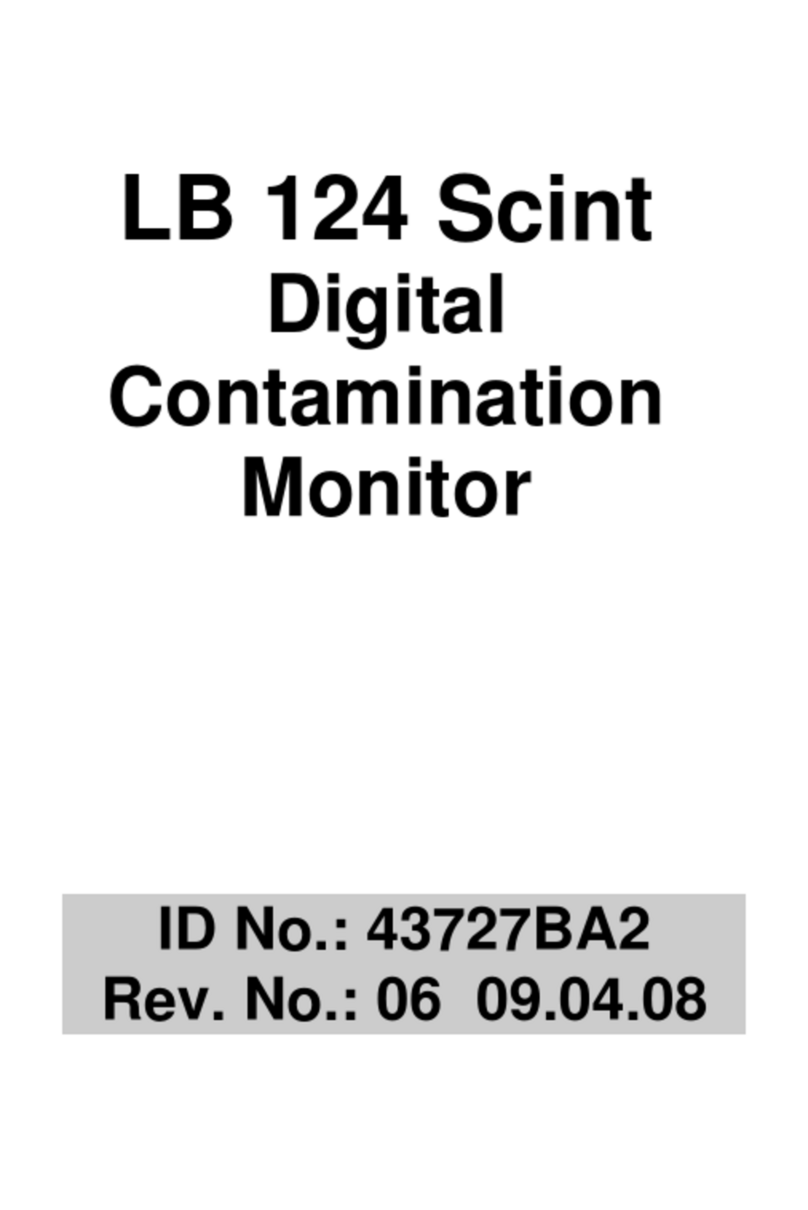
BERTHOLD TECHNOLOGIES
BERTHOLD TECHNOLOGIES LB 124 Scint Series User manual
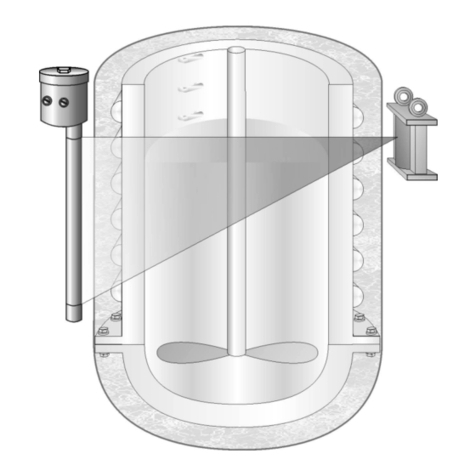
BERTHOLD TECHNOLOGIES
BERTHOLD TECHNOLOGIES Uni-Probe LB 490 User manual
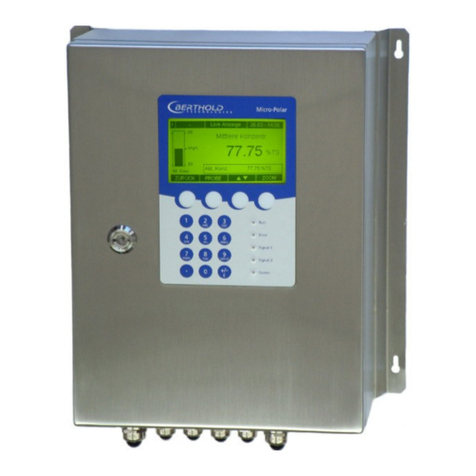
BERTHOLD TECHNOLOGIES
BERTHOLD TECHNOLOGIES LB 567 User manual
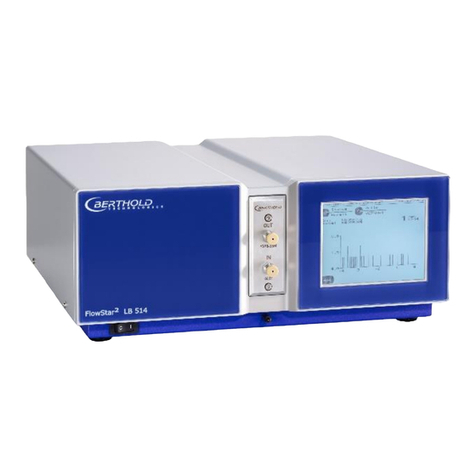
BERTHOLD TECHNOLOGIES
BERTHOLD TECHNOLOGIES FlowStar2 LB 514 User manual

BERTHOLD TECHNOLOGIES
BERTHOLD TECHNOLOGIES LB 444 User manual

BERTHOLD TECHNOLOGIES
BERTHOLD TECHNOLOGIES Junior LB 9509 User manual

BERTHOLD TECHNOLOGIES
BERTHOLD TECHNOLOGIES LB 480 User manual

